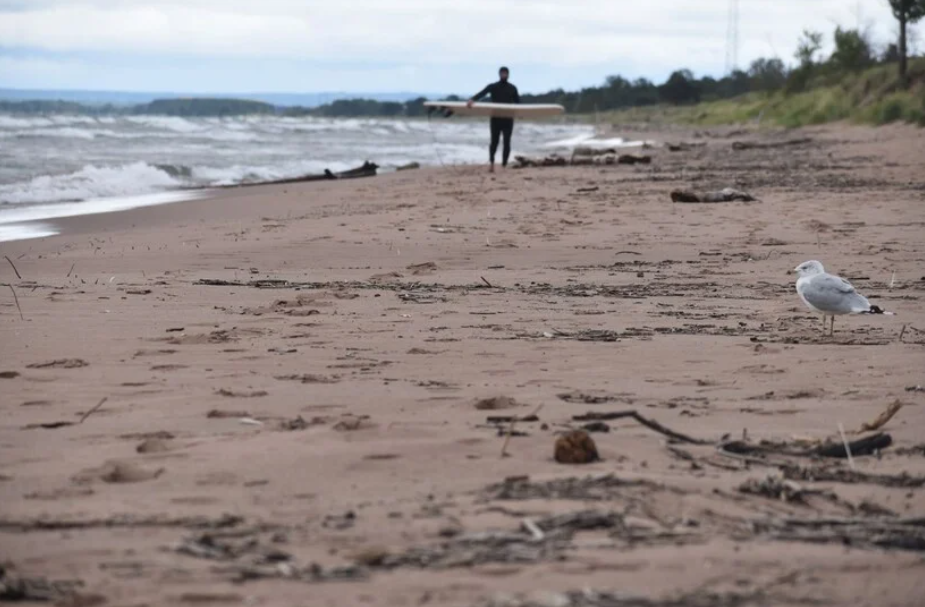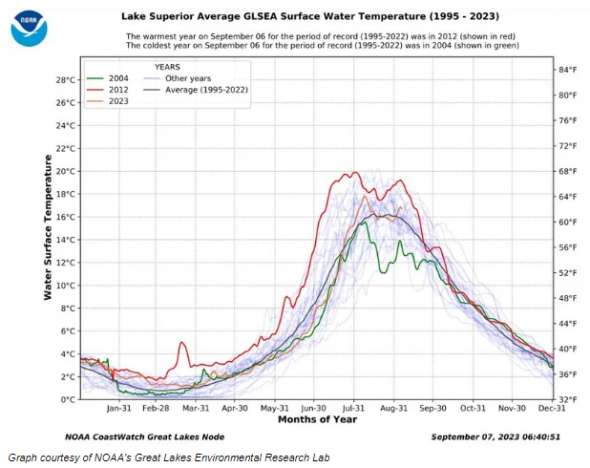Despite Spring Surge, Great Lakes Water Levels Held Steady This Summer
Water levels held unusually steady this summer when they would normally climb.

A surfer and a seagull walk along a Lake Superior beach in Duluth on Sept. 7, 2023. Water levels on the lake are still above their long-term average, but they rose little during the summer due to dry conditions. Danielle Kaeding/WPR
Water levels on the Great Lakes rose sharply earlier this year due to a very wet spring, but they have remained unusually steady over the summer on Lakes Superior and Michigan-Huron due to dry conditions.
Lake levels generally rise during the spring on the Great Lakes due to more rainfall and runoff from melting ice and snow before peaking during the summer. This year, most of that surge took place in the spring for those lakes, according to the U.S. Army Corps of Engineers.
For Lake Superior, the seasonal rise from March to May doubled from an average of 5 inches to roughly 10 inches this spring. Levels on Lake Michigan-Huron, which is considered by the Army Corps to be hydraulically one lake, saw a near average increase of around 11 inches during that span.
Since then, both Lake Superior and Lake Michigan-Huron rose less than an inch over the summer months, according to Deanna Fielder, a physical scientist with the Detroit District of the Army Corps.
“Those relatively steady levels (are) not typical. Usually, you continue to see that water level rise,” Fielder said.
In the Lake Superior basin, Fielder said that’s even rarer because the lake typically rises an average of 7 inches from May through August when water levels peak.
“You’re seeing that impact of those drier conditions, basically, through those summer months, where the lake was staying relatively steady,” Fielder said.
The same is true for Lake Michigan-Huron. Levels typically rise 3.5 to 4 inches from May to July.
“You did see some drought conditions develop especially on the western side of the lake,” Fielder said.
Over the past year, the Great Lakes basin has seen less than the average rainfall recorded over a 120-year span. The Lake Superior basin saw about 5 inches less rain than average during the last 12 months, and rainfall in the Lake Michigan-Huron basin was down more than 3.5 inches from average during the same period.
The latest U.S. Drought Monitor shows 96 percent of Wisconsin is abnormally dry. The Lake Michigan shoreline is seeing mostly moderate drought conditions, whereas parts of Lake Superior’s south shore are seeing severe to exceptional drought conditions.
Even so, Fielder said levels on the lakes remain above their long-term average. As they begin their seasonal decline, water levels are expected to remain above average but below record highs over the next six months.
Water levels in August remained above average on all the Great Lakes, but continued to be well below record high conditions. Seasonal declines have begun on all the lakes, as is typical for this time of year.https://t.co/GqMFHWxyLj pic.twitter.com/Slwo9LatuE
— Detroit District (@detroitdistrict) September 6, 2023
Although, there’s a small chance that dry conditions could push levels below average if the drought continues. Fielder noted the forecasts show below average rainfall is likely in the Lake Superior basin and northern part of Lake Michigan over the next three months.
Levels on Lake Michigan-Huron were 579.72 feet last month, which is down 28 inches from the monthly record high set in 2020. Levels on Lake Superior were 602.59 feet. That’s 7 inches below the lake’s August record high set in 2019.
Despite recent heat spells, water temperatures are around average.
Surface water temperatures of Lake Superior climbed about a couple degrees above average to 62 degrees Fahrenheit as many areas across the region tied or broke heat records over Labor Day weekend.
Even so, temperatures were cooler than normal for much of the summer on the lake until August, according to Jennifer Day. She’s a spokesperson for the National Oceanic and Atmospheric Administration’s Great Lakes Environmental Research Lab.
“We peaked this year around August 1,” Day said. “Then, (temperatures have) started coming down. Again, just in the last couple of days, they flipped up a couple of degrees, but we’re anticipating seeing them continue to drop through the rest of the year.”
 Day said spikes in air temperatures can heat up the surface of the lakes. Surface water temperatures peaked around 64 degrees on Lake Superior. On Lake Michigan, temperatures have fluctuated over the summer, but Day said they have remained below average since the first week of August. Over the Labor Day weekend, water temperatures were near average at around 68 to 69 degrees.”I’m sure that that creep just in the last few days moving up two or three degrees is because of the hot temperatures that we’ve been having,” Day said.
Day said spikes in air temperatures can heat up the surface of the lakes. Surface water temperatures peaked around 64 degrees on Lake Superior. On Lake Michigan, temperatures have fluctuated over the summer, but Day said they have remained below average since the first week of August. Over the Labor Day weekend, water temperatures were near average at around 68 to 69 degrees.”I’m sure that that creep just in the last few days moving up two or three degrees is because of the hot temperatures that we’ve been having,” Day said.
According to the lab’s data, temperatures peaked at around 72 degrees on Lake Michigan this summer.
Listen to the WPR report here
After a wet spring, dry conditions kept water levels from rising much on the Great Lakes this summer was originally published by Wisconsin Public Radio





















